.
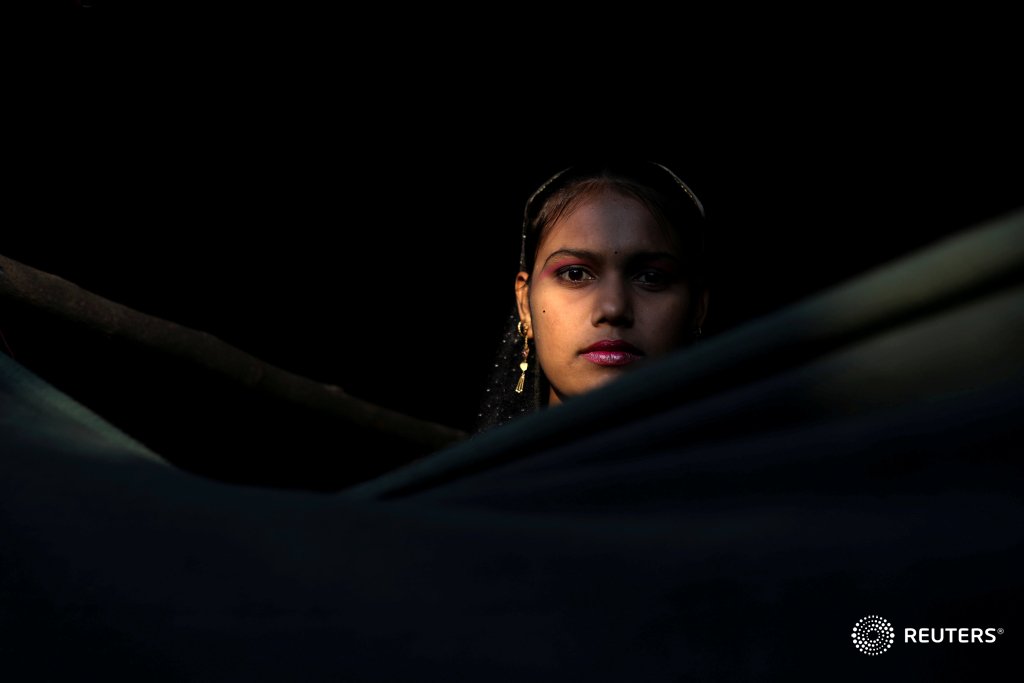
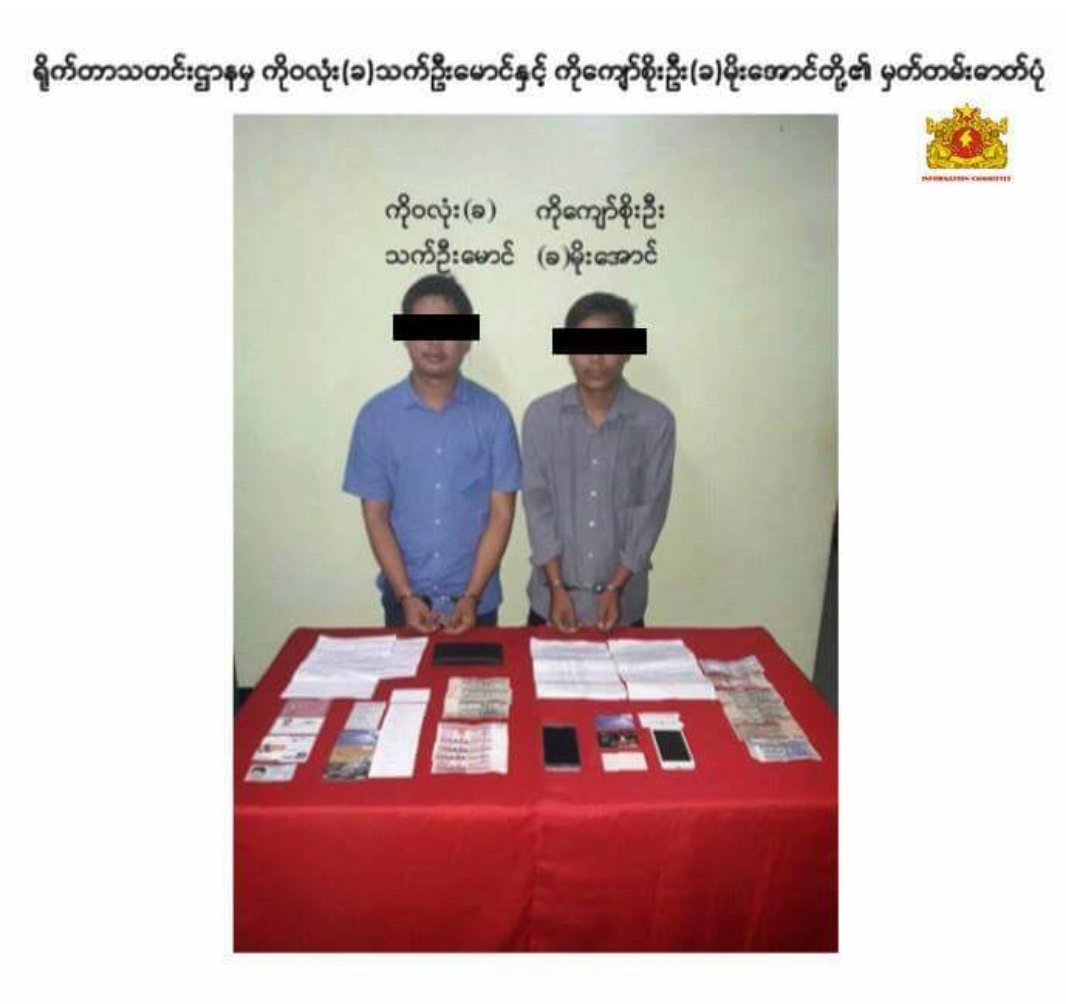
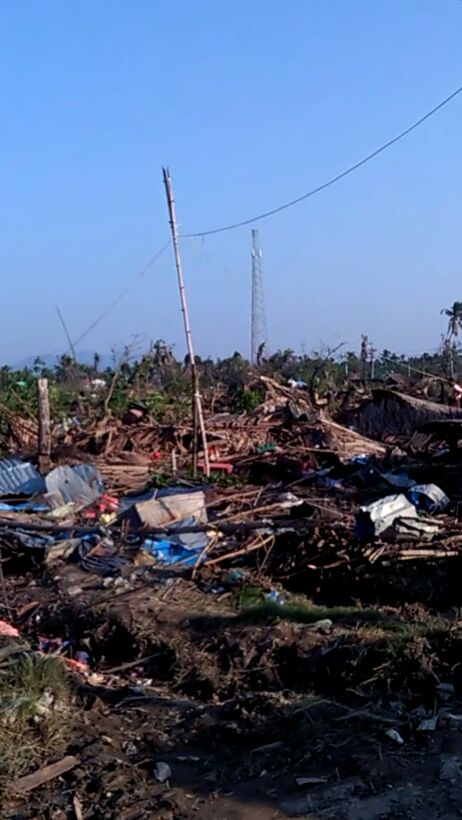

Mamataz Begum, 18, stands at the entrance of her shelter at a Rohingya refugee camp in Bangladesh: Photo @markodjurica: image via Reuters Pictures @reuterspictures, 15 December 2017

My
Reuters colleagues Wa Lone (left) and Kyaw Soe Oo were investigating
the Myanmar military's crackdown in Rakhine State when they were
arrested on Tuesday. The Myanmar government published this sickening
photo of them in handcuffs.: image via Andrew RC Marshall #Journotopia, 13 December 2017

#BREAKING
#Maungdaw Today (14th Dec) A #Mosque, a #Madarasa (Islamic School) and 6
houses intact in West Hamlet of Ward 5 were bulldozed by #Myanmar
authorities and #Rakhine mob. Rakhines took away Windows, Doors, Wood
and Zinc Sheets.: image via Ro Nay San Lwin @nslwin, 14 December 2017
My
Reuters colleagues Wa Lone and Kyaw Soe Oo were investigating the
Myanmar military's crackdown in Rakhine State when they were arrested on
Tuesday.: image via Andrew RC Marshall #Journotopia, 13 December 2017

In #Minbya Township, today (14th Dec) the authorities threatened all #Rohingya villagers. The authorities said they will take serious action if anyone refused to accept NVC (National Verification Card).: image via Ro Nay San Lwin @nslwin, 14 December 2017
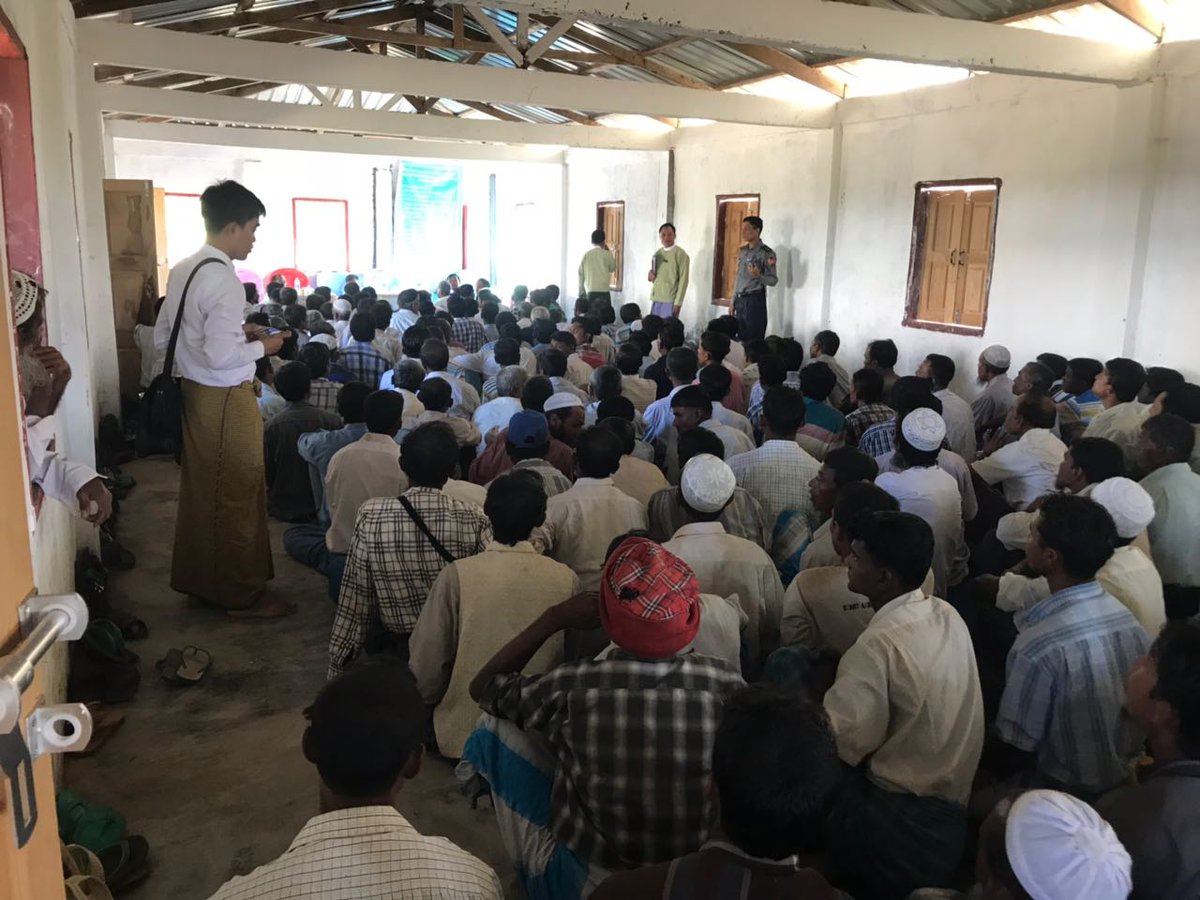
In #Minbya Township, today (14th Dec) the authorities threatened all #Rohingya villagers. The authorities said they will take serious action if anyone refused to accept NVC (National Verification Card).: image via Ro Nay San Lwin @nslwin, 14 December 2017

It is a phenomenon far less dramatic than the collapse of the Arab Spring, but no less consequential.: tweet via Jerome Taylor @Jerome Taylor, 15 December 2017
In Myanmar both the office of Aung San Suu Kyi, state media and the military have used the label “fakenews” to counter overwhelming evidence gathered by the international media and UN investigators that troops have committed widespread atrocities against the Rohingya.: tweet via Jerome Taylor @Jerome Taylor, 15 December 2017
In
Cambodia, both Hun Sen and pro-government propaganda outlets like
FreshNews rail against any critical coverage as some sort of foreign
inspired plot while decent, independent media outlets like Cambodia
Daily are shuttered.: tweet via Jerome Taylor @Jerome Taylor, 15 December 2017
The Philippines has perhaps SE Asia’s finest and most intrepid press corps of recent decades yet pro-Duterte trolls have launched highly successful smear campaigns against reporters or outlets who don’t toe the line on the brutal war on drugs.: tweet via Jerome Taylor @Jerome Taylor, 15 December 2017
Malaysia keeps more of a veneer of plurality than many neighbours but the likelihood is we will see the same government that has run the country for the last three decades, pushing an increasingly ethno-nationalist agenda, comfortably win elections next year.: tweet via Jerome Taylor @Jerome Taylor, 15 December 2017
Thailand is looking at a fourth year of what has been the most authoritarian government in a generation. Even if elections are held - and let’s face it that is still a big if - the new constitution guarantees the military huge influence over any future civilian government.: tweet via Jerome Taylor @Jerome Taylor, 15 December 2017
Laos and Vietnam remain deeply entrenched one party states. Like China, the idea that communist governments would have to liberalise and become less autocratic as their citizens got richer has remained a canard. Corruption and suppression of dissent remains endemic.: tweet via Jerome Taylor @Jerome Taylor, 15 December 2017
And
Indonesia, perhaps the region’s most vibrant democracy, is seeing a new
resurgence in identity politics and religious extremism that does not
bode well for the future.: tweet via Jerome Taylor @Jerome Taylor, 15 December 2017
At least 6,700 Rohingya were killed in the month after violence broke out in Myanmar in August, Medecins Sans Frontieres (MSF) says.
There have been plenty of detailed reports by journalists and researchers, based on interviews conducted with refugees, which make it hard to dispute that terrible human rights abuses took place at the hands of the security forces.
But many of these reports focussed on the worst cases; there are several media reports about a massacre at one village called Tula Toli. Some Rohingya I interviewed told me they had fled in fear of violence, but had not actually experienced it.
This well-researched figure by MSF suggests the operation conducted by the military was brutal enough to raise the possibility of taking a case to the International Criminal Court (ICC) for crimes against humanity.
The problem would be that Myanmar has not ratified the Rome Statute of the ICC and is not bound to co-operate with it. Bringing a case would require the approval of all five permanent members of the UN Security Council, and China has until now given its full support to the Myanmar government's handling of the crisis.
The military crackdown began on 25 August after Rohingya Arsa militants attacked more than 30 police posts.
After an internal investigation, the Myanmar army in November exonersted itself of any blame regarding the crisis.
It denied killing any civilians, burning their villages, raping women and girls, and stealing possessions.
The mostly Muslim minority are denied citizenship by Myanmar, where they are seen as immigrants from Bangladesh. The government does not use the term Rohingya but calls them Bengali Muslims.
The government's assertions contradicted evidence seen by BBC correspondents. The United Nations human rights chief has said it seems like "a textbook example of ethnic cleansing".
"What we uncovered was staggering, both in terms of the numbers of people who reported a family member died as a result of violence, and the horrific ways in which they said they were killed or severely injured," MSF Medical Director Sidney Wong said.
According to MSF:
"The numbers of deaths are likely to be an underestimation as we have not surveyed all refugee settlements in Bangladesh and because the surveys don't account for the families who never made it out of Myanmar," Mr Wong said.
In November, Bangladesh signed a deal with Myanmar to return hundreds of thousands of the refugees.
MSF said the agreement was "premature" pointing out that "currently people are still fleeing" and reports of violence have come even in recent weeks.
The group also warned there was still very limited access for aid groups into Rakhine state.
The Rohingya are a stateless Muslim minority who have long experienced persecution in Myanmar.
MSF estimates more than 6,700 Rohingya killed in a month in Myanmar: BBC News, 14 December 2017
At least 6,700 Rohingya were killed in the month after violence broke out in Myanmar in August, Medecins Sans Frontieres (MSF) says.
Based on surveys of refugees in Bangladesh, the number is much higher than Myanmar's official figure of 400.
MSF said it was "the clearest indication yet of the widespread violence" by Myanmar authorities.
The Myanmar military blames the violence on "terrorists" and has denied any wrongdoing.
More than 647,000 Rohingya have fled into Bangladesh since August, MSF says.
The aid group's survey found that at least 9,000 Rohingya died
in Myanmar, also known as Burma, between 25 August and 24 September.
"In
the most conservative estimations" at least 6,700 of those deaths have
been caused by violence, including at least 730 children under the age
of five, according to MSF.
Previously, the armed forces stated that around 400 people had been killed, most of them described as Muslim terrorists.
A case for the International Criminal Court? Jonathan Head, South East Asia Correspondent, BBC News, 14 December 2017
There have been plenty of detailed reports by journalists and researchers, based on interviews conducted with refugees, which make it hard to dispute that terrible human rights abuses took place at the hands of the security forces.
But many of these reports focussed on the worst cases; there are several media reports about a massacre at one village called Tula Toli. Some Rohingya I interviewed told me they had fled in fear of violence, but had not actually experienced it.
This well-researched figure by MSF suggests the operation conducted by the military was brutal enough to raise the possibility of taking a case to the International Criminal Court (ICC) for crimes against humanity.
The problem would be that Myanmar has not ratified the Rome Statute of the ICC and is not bound to co-operate with it. Bringing a case would require the approval of all five permanent members of the UN Security Council, and China has until now given its full support to the Myanmar government's handling of the crisis.
The military crackdown began on 25 August after Rohingya Arsa militants attacked more than 30 police posts.
After an internal investigation, the Myanmar army in November exonersted itself of any blame regarding the crisis.
It denied killing any civilians, burning their villages, raping women and girls, and stealing possessions.
The mostly Muslim minority are denied citizenship by Myanmar, where they are seen as immigrants from Bangladesh. The government does not use the term Rohingya but calls them Bengali Muslims.
The government's assertions contradicted evidence seen by BBC correspondents. The United Nations human rights chief has said it seems like "a textbook example of ethnic cleansing".
"What we uncovered was staggering, both in terms of the numbers of people who reported a family member died as a result of violence, and the horrific ways in which they said they were killed or severely injured," MSF Medical Director Sidney Wong said.
According to MSF:
- 69% of the violence-related deaths were caused by gunshots
- 9% were due to being burnt to death in their houses
- 5% were beaten to death.
"The numbers of deaths are likely to be an underestimation as we have not surveyed all refugee settlements in Bangladesh and because the surveys don't account for the families who never made it out of Myanmar," Mr Wong said.
In November, Bangladesh signed a deal with Myanmar to return hundreds of thousands of the refugees.
MSF said the agreement was "premature" pointing out that "currently people are still fleeing" and reports of violence have come even in recent weeks.
The group also warned there was still very limited access for aid groups into Rakhine state.
The Rohingya are a stateless Muslim minority who have long experienced persecution in Myanmar.

Dilbar Begum and her daughter Noor Kalima, 10, are the only survivors of a family of six. Noor’s scars were left by the machetes of Myanmar soldiers.: photo by Tomas Munita for The New York Times, 15 December 2017
As
a human, I couldn't control my tears when I had face-to-face
conversation with Dilbar and her daughter Noor. Also with Dilbar's
sister Mumtaz and her daughter.: tweet via Ro Nay San Lwin @nslwin, 15 December 2017
Is this Genocide? Survivors describe Myanmar soldiers killing men, raping women, and burning babies in Rohingya villages: Nicholas Kristof, The New York Times, 15 December 2017
SOUTHEAST BANGLADESH, NEAR THE MYANMAR BORDER — “Ethnic cleansing” and even “genocide” are antiseptic and abstract terms. What they mean in the flesh is a soldier grabbing a crying baby girl named Suhaifa by the leg and flinging her into a bonfire. Or troops locking a 15-year-old girl in a hut and setting it on fire.
The
children who survive are left haunted: Noor Kalima, age 10, struggles
in class in a makeshift refugee camp. Her mind drifts to her memory of
seeing her father and little brother shot dead, her baby sister’s and
infant brother’s throats cut, the machete coming down on her own head,
her hut burning around her … and it’s difficult to focus on
multiplication tables.
“Sometimes I can’t concentrate on my class,” Noor explained. “I want to throw up.”
In
the past I’ve referred to Myanmar’s atrocities against its Rohingya
Muslim minority as “ethnic cleansing,” but increasingly there are
indications that the carnage may amount to genocide. The U.S. Holocaust
Memorial Museum, backed by a Myanmar-focused human rights organization
called Fortify Rights, argues that there is “growing evidence of genocide,” and Yale scholars made a similar argument even before the latest spasms of violence.
Romeo Dallaire, a legendary former United Nations general, describes it as "very deliberate genocide."
The U.N. human rights chief, Zeid Ra’ad al-Hussein, told me, “It would
not surprise me at all if a court in the future were to judge that acts
of genocide had taken place.”
You
judge: Here’s what Noor and her mother, Dilbar Begum, say happened in
their village, Tula Toli. First, the Myanmar Army separated the women
and girls from the men and boys.
“Then they shot the men and boys,” Dilbar recalled. “I saw them kill my husband and son. I was screaming.”
I delicately tried to probe whether Noor had seen the murders of her father and brother, who was just 4 years old.
“I
saw everything,” Noor said, biting her lip. In a rush of words, she
added: “My father was the best man in the world. We were a good team.”



Rohingya women waiting for aid along the Teknaf Road in Bangladesh. Myanmar is visible beyond the Naf River.: photo by
Tomas Munita for The New York Times, 15 December 2017

Rohingya women waiting for aid along the Teknaf Road in Bangladesh. Myanmar is visible beyond the Naf River.: photo by
Tomas Munita for The New York Times, 15 December 2017
She began to cry, and soon my interpreter was wiping away tears, too. And so was I.
The Myanmar soldiers herded the women and girls into huts to be raped. Noor and Dilbar were taken into one hut, along with Noor’s 2-year-old sister, Rozia, and another brother, Muhammad Kashel, a baby still nursing.
“They
took my baby and cut his throat,” Dilbar said in a trembling voice,
adding that the soldiers then cut Rozia’s throat, too. Shortly
afterward, Noor remembers a machete blade smashing down repeatedly on
her own head, her mother screaming in the background. Then she collapsed
unconscious.
Dilbar
said the soldiers then yanked an earring from her ear — she pointed to
her torn lobe — and assaulted her beside the bodies of her children:
“One soldier held me down, and another raped me.” When they were
finished, she said, the soldiers chopped her on the head with the
machete — she has the same angry scars on her scalp as her daughter —
and left her for dead while setting fire to the hut.
The fire and smoke roused her, she said. She checked the bodies of her children and found that Noor was still breathing. Grabbing the girl, she ran into the woods. Dazed, they hiked for two days through the woods to get to the Bangladesh border.
The
global and American responses have been feeble, so Myanmar is getting
away with murder and rape intended to change the country’s demography.
The lesson that the world’s complacency sends to other countries is that
this is an ideal time to eradicate a vexing ethnic group.
Daw Aung San Suu Kyi, the Nobel Peace Prize winner, has become the apologist for these mass atrocities. Daw Suu does not control the Myanmar Army,
but she has defended the military operation and mocked “a huge iceberg
of misinformation.” Her Facebook page scoffed at a Rohingya woman’s
report of sexual assault by soldiers as "fake rape."
Daw
Suu, if you’re reading this, I hope that for a moment you’ll open your
heart and listen to the story of Hasina Begum, 21, and her 1-year-old
daughter, Suhaifa. (Begum is a common honorific for women.)


Hasina Begum, right, with her sister-in-law, Asma Begum.: photo by
Tomas Munita for The New York Times, 15 December 2017
Myanmar
soldiers held Hasina and other village women at gunpoint, she said,
while the troops executed the men and boys, doused the bodies with
gasoline and turned the corpses into a bonfire. Then the troops led the
women and girls, five at a time, toward a hut.
“I
was trying to hide my baby under my scarf, but they saw her leg,”
Hasina recalled, her voice brittle, her mouth trembling. “They grabbed
my baby by the leg and threw her onto the fire.”
Hasina
said she collapsed on the ground, screaming. The impatient soldiers
then began to club her — she showed me scars from the beating — and
dragged her into a hut with her sister-in-law, Asma Begum. The soldiers
stripped the women naked and raped them, she said, and finally closed
the door and set the hut on fire.
As
bits of the burning roof fell down on them, Hasina said, she and Asma
broke a hole in the side of the hut and ran away naked. They rolled in
mud to soothe their burns, and the next day they found a Rohingya house
and begged for the man inside to throw out clothes so that they could
cover themselves.
A
three-day hike took Hasina and Asma to Bangladesh. But Hasina still
suffers from the beating and from the emptiness left by the murder of
Suhaifa, and she has trouble sleeping.
“When I fall asleep, I look for my baby,” she said. “I wake up screaming.”
It’s tempting to say: That’s terrible, but it’s not our problem. But
Noor’s plight, like Anne Frank’s in the 1940s, should prick the global
conscience, for one lesson of history is this: Crimes against humanity
are an offense against all humanity and require a response from all of us.
The
latest slaughter began in August after a shadowy Rohingya rebel force
attacked police and army posts, killing 12 members of the security
forces. Myanmar’s Army embarked on a scorched-earth counterinsurgency, and when soldiers couldn’t find rebels, they unleashed their fury on civilians.
The brutality varied widely by area, and what happened in Noor’s village was worse than typical. Human Rights Watch says, based on satellite images, that some 345 villages were burned. No one knows exactly what happened to many Rohingya: I searched for people from Rohingya villages I had visited in Myanmar in 2014 and 2015 but couldn’t find them.

The line for aid at a refugee camp in Unchiprang, Bangladesh.: photo by
Adam Dean for The New York Times, 15 December 2017

The line for aid at a refugee camp in Unchiprang, Bangladesh.: photo by
Adam Dean for The New York Times, 15 December 2017
Doctors Without Borders calculated that at least 9.000 Rohingya, including 1,000 small children, died after the army’s attacks, which were undertaken with a savagery that left hardened war correspondents shaken. These attacks involved the systematic use of rape to terrorize the Rohingya.
One
14-year-old girl confided her deepest secret: Four soldiers had
gang-raped her. She had intended to keep the secret forever, but then
she became pregnant and quietly sought medical help. An aid worker
helped her get an abortion, but she still hasn’t told even her parents.
She shared her story with me only because she is so grateful to the aid
organization and it told her that I could be trusted.
It’s impossible to know how many women and girls have been raped, but doctors in the refugee camps report a surge in pregnancies as a result of rape, and I encountered two women who suffered fistulas caused by rape.
The
Rohingya who have reached Bangladesh live in vast, sprawling refugee
encampments, where I interviewed them in their tents and shacks; aid
organizations provide desperately needed food, water, toilets and
medical care, but cannot offer hope. Bangladesh does not want the
Rohingya and does not allow aid organizations to teach Bengali, the
national language, or to offer an education beyond primary school.


"My drawing shows a bullet
hitting my next door neighbor. First they told us to leave, then they
shot my neighbor. His name was Aiyukhan. When we were running away, we
saw people killed. First, they shot them, and then if they didn’t die
they stabbed them and then they cut their throats.” — Ashidulla, 12: photo by
Alessandra Montalto/The New York Times, 15 December 2017
An organization called BRAC
runs child centers where children are given paper and pens. Their
drawings are wrenching: soldiers shooting guns, friends bleeding, huts
burning.
“That
man being shot is Sayid Azam, my neighbor,” said Ismal, an 11-year-old
orphan, explaining his drawing of a huge gun firing at a man. “I saw it.
I was hiding behind a bush.”
China has proposed a plan that would result in the return of the refugees to Myanmar, presumably to live stateless in concentration camps like the ones for Rohingya that I've previously reported on. But most are too terrified to contemplate returning. It would be an outrage to force refugees back.


Shafika Begum: photo by Patrick Brown/Panos, via UNICEF, 15 December 2017
Consider
Shafika Begum, a 15-year-old who may be the only survivor in her
family. She said she saw soldiers shoot dead her father and four
brothers; they then took her, her mother and her 11-year-old sister into
a hut. The soldiers cut her sister’s throat in front of her, and she
said that when she screamed, the soldiers clubbed her on the head and
knocked her out.
Flames
and smoke brought her back to consciousness: The soldiers had locked
the door of the hut and set it on fire. Her mother and sister were dead,
and Shafika’s clothes were on fire, but she broke through a wall and
fled.
Was
she raped? “I was unconscious, so I don’t know what they did to me,”
she said. But she added that someone had rearranged her clothes.
Shafika
walked for four days through the jungle to get to Bangladesh. Her back,
left hand and both feet are burned, and she has no money to buy burn
medicine. I was concerned that interviewing her might traumatize her
again, but she was determined to speak.
“I want to tell the whole world my story,” she said. “I want to tell what happens in Myanmar.”
The three people whose stories I’ve focused on — Noor, the 10-year-old; Hasina, whose baby was thrown onto the fire; and Shafika, disfigured by burns — are all from the same village, Tula Toli. All these atrocities that I’ve described unfolded on a single dot of the map — and in every direction there are other villages with tragedies of their own.
Are the stories they recount true?


"My mother died earlier, and
my father was killed by a bullet. We were running away, and I heard him
killed, but I didn’t see it. My father ran back to get things, and he
was shot. I heard him groaning, but I didn’t see him killed. Others told
me that he had died. My two older brothers and my sister are looking
after me now.” — Ismal, 11: photo by
Alessandra Montalto/The New York Times, 15 December 2017
One
thing I’ve learned over the decades (originally while covering China’s
murder of Tiananmen democracy protesters in 1989) is that victims lie as
well as perpetrators. Outrage leads to exaggerations, to elevated death
tolls, to rumors becoming eyewitness accounts. But the attack on Tula
Toli has been well documented by human rights organizations, including
Amnesty International, Human Rights Watch and Fortify Rights, and it is
substantiated by satellite photos showing the burned huts. In all, I
spoke to seven people who said they were survivors from Tula Toli, and
their stories meshed and cross-confirmed one another.
There
is no easy solution to possible genocide; there never is. But
accountability helps, so there should be a major push to prosecute
Myanmar military officials in the International Criminal Court. Judges
can resolve whether these crimes against humanity also amount to
genocide.
An open letter from 58 human rights and aid groups has rightly called for targeted sanctions on Myanmar officials. The House of Representatives this month passed a resolution denouncing the ethnic cleansing, and both the Senate and the House have bipartisan legislation pending that would impose sanctions on Myanmar officials, yet it seems unlikely to become law any time soon.
Secretary of State Rex Tillerson has commendably described the situation as ethnic cleansing
and has said that “the world can’t just stand idly by and be witness to
the atrocities.” But I fear that’s exactly what is happening. Myanmar
may have concluded that its slaughter is a success — denunciations from
bleeding-heart journalists and human rights groups are an acceptable
price for eliminating half of its Rohingya population.
We
do know that international sanctions and pressure matter to Myanmar’s
generals, because those were what led them to step back and hold
elections. But so far there hasn’t been enough pressure exerted to stop
the barbaric treatment of the Rohingya.

"I saw people killed. If we hadn’t run, it would have happened to us.” — Sawyid Korim, 12: photo by Alessandra Montalto/The New York Times, 15 December 2017

"I saw people killed. If we hadn’t run, it would have happened to us.” — Sawyid Korim, 12: photo by Alessandra Montalto/The New York Times, 15 December 2017
For individuals wondering how to help, there are fine organizations working on the ground in the camps, among them BRAC, Doctors Without Borders, Save the Children and the Hope Foundation for Women and Children of Bangladesh. First-rate advocacy on behalf of the Rohingya has been led by Fortify Rights, Human Rights Watch and Amnesty International.
A
Times colleague asked how I can report on these atrocities and not lose
faith in humanity. The answer is that I see not only the evil, but also
among the survivors a truly inspiring resilience and courage. I am awed
by people like Dilbar, Hasina and Shafika with the physical and mental
strength to escape through the mountains and then the moral strength to
speak out about sexual violence meant to humiliate them into silence.
Hasina
may be exhausted from nightmares about searching for her baby, but she
displays a moral clarity that world leaders can emulate. “They killed my
family members, and they killed my world,” she told me. “When I tell my
story, I feel terrible, and afterward I go cry to myself. But we need
justice, and maybe this will help.”
Brave survivors like her ensure that we will never be able to shrug and say: If only we had known. We know.

Nur Begum, who doesn't know her age but thinks she is between 14 and 16 years old, has her hair done on the day of her wedding to Rayeed Alam, 20, in a Bangladesh refugee camp in Cox's Bazar, Bangladesh, on November 30, 2017. Nur said that her parents arranged the marriage for her and she had no choice in the matter.: photo by Allison Joyce / Getty, 30 November 2017

Shoes and makeup belonging to Nur Begum sit on a
mat on the day of her wedding to Rayeed Alam in a Bangladesh refugee
camp in Cox's Bazar, Bangladesh, on November 30, 2017.: photo by Allison Joyce / Getty, 30 November 2017
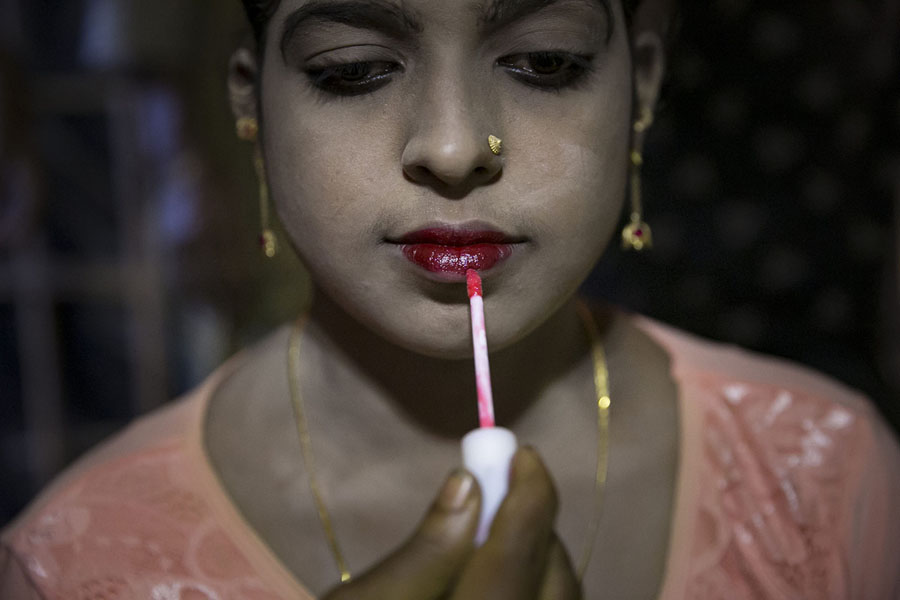
Nur Begum has her makeup done on the day of her
wedding to Rayeed Alam in a Bangladesh refugee camp in Cox's Bazar on
November 30, 2017.: photo by Allison Joyce / Getty, 30 November 2017

Nur Begum is prepared on the day of her wedding to Rayeed Alam on November 30, 2017.: photo by Allison Joyce / Getty, 30 November 2017

Nur Begum walks to her husband's house with her family on the day of her wedding in a Bangladesh refugee camp in Cox's Bazar on November 30, 2017.: photo by Allison Joyce / Getty, 30 November 2017
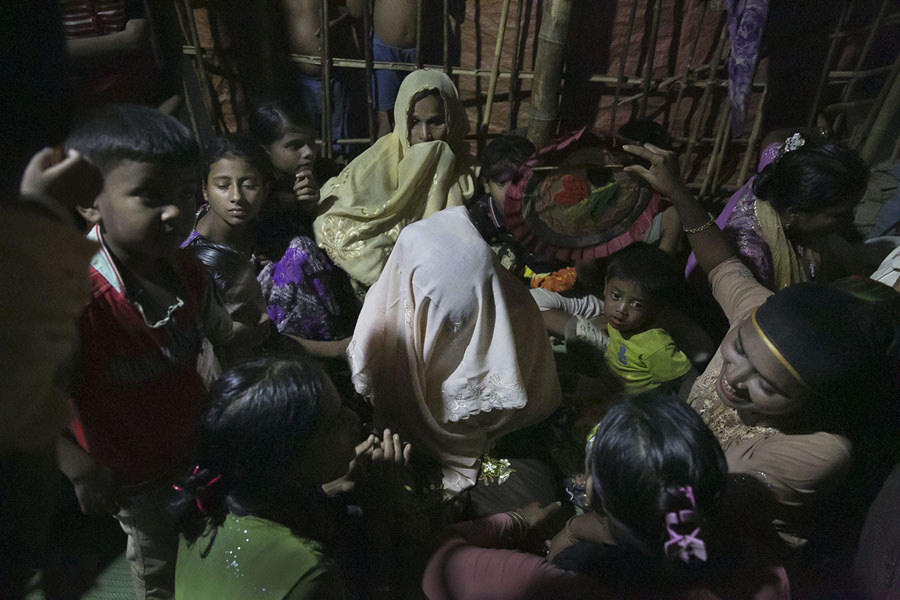
Women crowd around Nur Begum on the day of her wedding to Rayeed Alam on November 30, 2017.: photo by Allison Joyce / Getty, 30 November 2017

Rayeed Alam, 20, is seen during his wedding to Nur Begum on November 30, 2017. Rayeed came to Bangladesh with his family shortly after the August 25th attack. He says the military attacked his village and shot people, burned houses, and raped women. It took him three days to walk to the Bangladesh border.: photo by Allison Joyce / Getty, 30 November 2017


Nur Begum is prepared on the day of her wedding to Rayeed Alam on November 30, 2017.: photo by Allison Joyce / Getty, 30 November 2017

Nur Begum walks to her husband's house with her family on the day of her wedding in a Bangladesh refugee camp in Cox's Bazar on November 30, 2017.: photo by Allison Joyce / Getty, 30 November 2017

Women crowd around Nur Begum on the day of her wedding to Rayeed Alam on November 30, 2017.: photo by Allison Joyce / Getty, 30 November 2017

Rayeed Alam, 20, is seen during his wedding to Nur Begum on November 30, 2017. Rayeed came to Bangladesh with his family shortly after the August 25th attack. He says the military attacked his village and shot people, burned houses, and raped women. It took him three days to walk to the Bangladesh border.: photo by Allison Joyce / Getty, 30 November 2017

Women dance around Nur Begum (not pictured) on the day of her wedding to Rayeed Alam.: photo by Allison Joyce / Getty, 30 November 2017

Nur Begum sits segregated from the men on the day
of her wedding in a Bangladesh refugee camp on November 30, 2017. Her
husband Rayeed's parents arranged the marriage because all of his
sisters are already married and his mother needed someone to cook and
look after her and her husband.: photo by Allison Joyce / Getty, 30 November 2017


Nur Begum, who doesn't know her age but thinks she is between 14 and 16 years old, poses for a photo with her new husband, Rayeed Alam, 20, on the day of their wedding, November 30, 2017.: photo by Allison Joyce / Getty, 30 November 2017
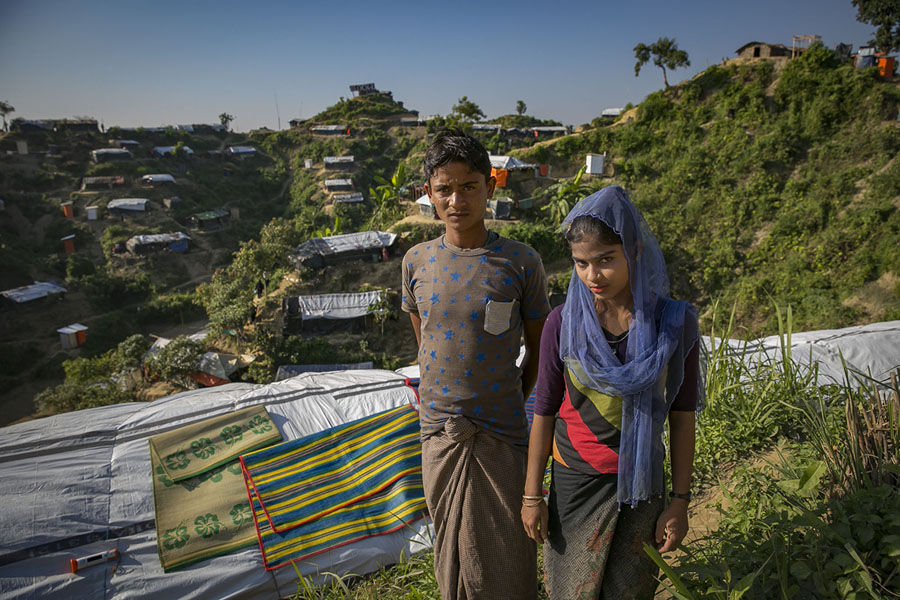
Mohammad Eliyas, 18, and Tasmina Begum, 16, pose in Cox's Bazar, Bangladesh, on November 26, 2017. They married in a Bangladesh refugee camp four days earlier. They fled after the August 25th attack when the military came to their village, burning houses and raping women. Eliyas says "My parents are very old and have no one to take care of them and have no one to cook for them, so they decided I should get married. I'm a man, how can I cook? It was my parents decision that I should marry her; it's no problem that she's young. I have to do what my parents say." Tasmina says, "My father wanted me to get married so I couldn't say no.": photo by Allison Joyce / Getty, 26 November 2017

Sabakur Nahar, 15 prays in her tent in Cox's Bazar on November 29, 2017. She married Rahul Amin, 20, two months earlier in a Bangladesh refugee camp.: photo by Allison Joyce / Getty, 29 November 2017

Recently-wed husband and wife Rahul Amin, 20, and
Sabakur Nahar, 15, pose for a photo on November 29, 2017, in Cox's
Bazar, Bangladesh. Rahul is from Tula Toli and Sabakur is from Bouli
Bazar. They both fled to Bangladesh after the August 25th attack. Rahul
lost 20 relatives in the attack and spent days walking to Bangladesh,
hiding in the forest and drinking water from the paddy fields along the
way. Sabakur saw her father killed by the military and lost six
relatives during the attack. She got separated from the rest of her
family and spent eight days walking to Bangladesh.: photo by Allison Joyce / Getty, 29 November 2017


Amina Begum, 15, from Butidong Kancapara village in Myanmar, cries on her wedding day in a Bangladesh refugee camp on November 25, 2017. Her husband, Munir, 22, is from same village.: photo by Allison Joyce / Getty, 25 November 2017
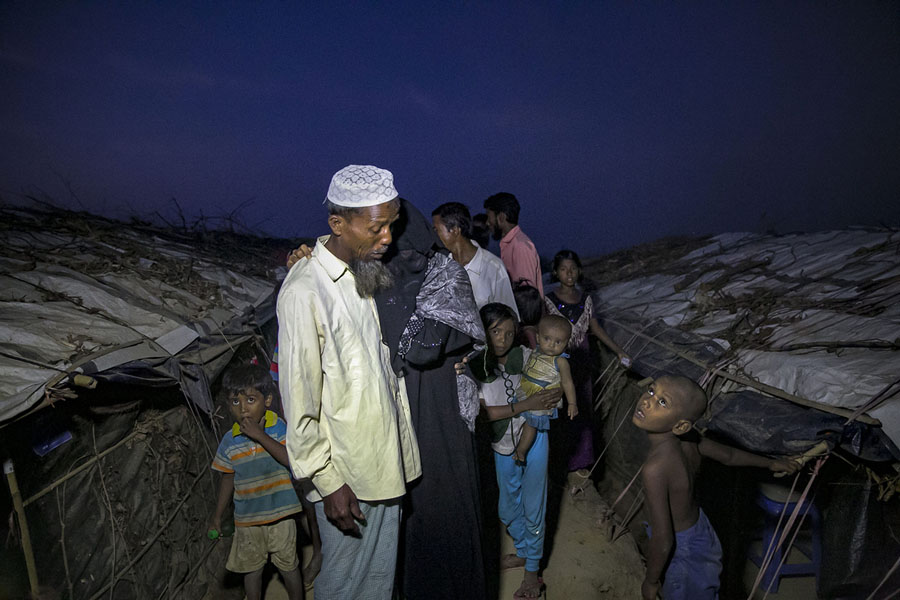
Amina Begum cries on her father's shoulder on her wedding day in a Bangladesh refugee camp on November 25, 2017. Amina and her family fled their village after the August 25th attack when the army and Buddhists opened fire on the village. They had to walk for 13 days to the Bangladesh border, sleeping in the forest and taking shelter in other villages on the way. Amina's father has eight children: five girls and three boys. He says "I already have a lot of daughters, if I marry them off it's good for me. If I get the opportunity I will marry the rest off as soon as possible. If I die, who will take responsibility for them?" Munir says "I think 18 is the best age for a girl to get married, but we knew each other in the village so it's okay.": photo by Allison Joyce / Getty, 25 November 2017


Amina Begum, 15, sits with her new husband, 22-year-old Munir, after their marriage ceremony in a Bangladesh refugee camp on November 25, 2017.: photo by Allison Joyce / Getty, 25 November 2017

Farmina Begum, 16, (center, in yellow) is seen on the day of her wedding to 18-year-old Hashimullah, in a Bangladesh refugee camp on November 27, 2017.: photo by Allison Joyce / Getty, 27 November 2017


Rahul Amin and Sabakur Nahar pose for a photo on
November 29, 2017, in Cox's Bazar, Bangladesh. They met in Bangladesh at
the Kutupalong transit center. He says that he thought she was
beautiful so he approached her and they started talking. After three
days he proposed marriage to her. She told him yes, but that she
couldn't marry him until she found her family. Eventually she gave up
hope and they were married a few days later. A few weeks after that she
located her family in a camp. Rahul says "Her age didn't matter to me,
her body structure isn't young and small, she looks older, so it's okay.
In our culture, women who look older have to get married. If other
people see her they'll criticize her family, saying your daughter is
getting older she needs to get married now. In Islam, any girl who looks
older and is seen outside of the house, it's bad for her family. In the
Koran, it says that if anyone sees a girl outside of the house, she
will be cursed." Sabakur says "I wanted to wait until I was 18 to get
married; 15 is too young. I agreed because I didn't have my family here.
If I was in Myanmar I never would have agreed to get married. I was all
alone here, so I agreed.": photo by Allison Joyce / Getty, 29 November 2017

Abdul Karim, 20 and Arifa Begum, 16, pose for a
photo in Cox's Bazar, Bangladesh, on November 29, 2017. They were
married in a Bangladesh refugee camp one week earlier. Arifa fled to
Bangladesh from Bouli Bazar in Myanmar and Abdul fled from Tula Toli,
both after the August 25th attack. Abdul says "I didn't want to get
married; I wanted to wait until I can go home to Myanmar. I have no work
here; how can I support a family? My father wanted me to get married
because food ration cards are given to individual families here." Arifa
says, "I didn't want to get married, but I can't deny my parents'
wishes. My father wanted me to get married; I don't have a choice. I
have to do what he says." Arifa's father, Abdul Mabub says "I don't have
enough food to feed her. The camp is unsafe and marriage means safety.
I'm not home to look after her all the time, now her new family looks
after her and she's not my responsibility anymore." : photo by Allison Joyce / Getty, 29 November 2017

Amina Begum, 15, from Butidong Kancapara village in Myanmar, cries on her wedding day in a Bangladesh refugee camp on November 25, 2017. Her husband, Munir, 22, is from same village.: photo by Allison Joyce / Getty, 25 November 2017

Amina Begum cries on her father's shoulder on her wedding day in a Bangladesh refugee camp on November 25, 2017. Amina and her family fled their village after the August 25th attack when the army and Buddhists opened fire on the village. They had to walk for 13 days to the Bangladesh border, sleeping in the forest and taking shelter in other villages on the way. Amina's father has eight children: five girls and three boys. He says "I already have a lot of daughters, if I marry them off it's good for me. If I get the opportunity I will marry the rest off as soon as possible. If I die, who will take responsibility for them?" Munir says "I think 18 is the best age for a girl to get married, but we knew each other in the village so it's okay.": photo by Allison Joyce / Getty, 25 November 2017

Munir, 22, sits segregated from his bride, Amina
Begum, and other women during his marriage ceremony in a Bangladesh
refugee camp on November 25, 2017.: photo by Allison Joyce / Getty, 25 November 2017

Amina Begum sits segregated by a curtain from her husband and other men during her marriage ceremony on her wedding day in Cox's Bazar, Bangladesh, on November 25, 2017.: photo by Allison Joyce / Getty, 25 November 2017

Amina Begum sits segregated by a curtain from her husband and other men during her marriage ceremony on her wedding day in Cox's Bazar, Bangladesh, on November 25, 2017.: photo by Allison Joyce / Getty, 25 November 2017

Amina Begum, 15, sits with her new husband, 22-year-old Munir, after their marriage ceremony in a Bangladesh refugee camp on November 25, 2017.: photo by Allison Joyce / Getty, 25 November 2017

Farmina Begum, 16, (center, in yellow) is seen on the day of her wedding to 18-year-old Hashimullah, in a Bangladesh refugee camp on November 27, 2017.: photo by Allison Joyce / Getty, 27 November 2017

Farmina Begum, on the day of her wedding to
18-year-old Hashimullah, in Cox's Bazar, Bangladesh, on November 27,
2017. Farmina and her family fled on August 25th after the military
attacked their village of Kullung. The military came to their village
and burned houses and shot people. They hid in the hills for eight days
and spent five days walking to the Bangladesh border.: photo by Allison Joyce / Getty, 27 November 2017
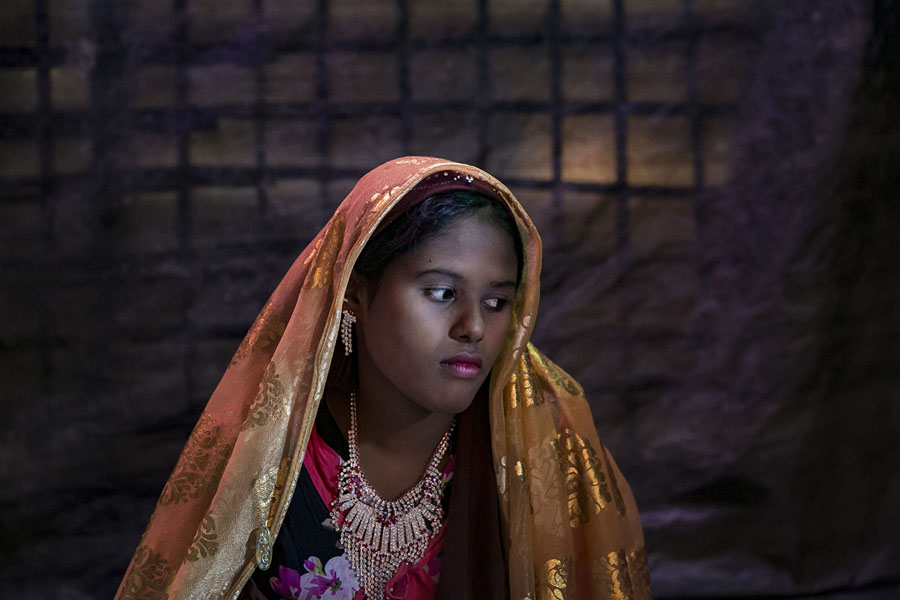
Farmina Begum, on the day of her wedding to Hashimullah, in a Bangladesh refugee camp, on November 27, 2017. Hashimullah and Farmina met at the water pump in the Bangladesh refugee camp near their home and he proposed to her father and he agreed to the marriage. Farmina's mother says "When we got his proposal we agreed because we don't enough food to feed her. If she got married, she would then be her husband's responsibility. She's getting older and and older girls shouldn't be single.": photo by Allison Joyce / Getty, 27 November 2017

Hashimullah sits during his marriage ceremony to Farmina Begum on November 27, 2017.: photo by Allison Joyce / Getty, 27 November 2017

Farmina Begum (right) talks to her friend on the day of her wedding on November 27, 2017.: photo by Allison Joyce / Getty, 27 November 2017

Women peer through the wall separating men from women on the day of the wedding of Farmina Begum to Hashimullah.: photo by Allison Joyce / Getty, 27 November 2017

Farmina Begum sits on one side of a wall separating women from men on the day of her wedding.: photo by Allison Joyce / Getty, 27 November 2017

18-year-old Hashimullah poses for a photo with his new bride, 16-year-old Farmina Begum on the day of their wedding in a Bangladesh refugee camp in Cox's Bazar, Bangladesh, on November 27, 2017: photo by Allison Joyce / Getty, 27 November 2017

Farmina Begum, on the day of her wedding to Hashimullah, in a Bangladesh refugee camp, on November 27, 2017. Hashimullah and Farmina met at the water pump in the Bangladesh refugee camp near their home and he proposed to her father and he agreed to the marriage. Farmina's mother says "When we got his proposal we agreed because we don't enough food to feed her. If she got married, she would then be her husband's responsibility. She's getting older and and older girls shouldn't be single.": photo by Allison Joyce / Getty, 27 November 2017

Hashimullah sits during his marriage ceremony to Farmina Begum on November 27, 2017.: photo by Allison Joyce / Getty, 27 November 2017

Farmina Begum (right) talks to her friend on the day of her wedding on November 27, 2017.: photo by Allison Joyce / Getty, 27 November 2017

Women peer through the wall separating men from women on the day of the wedding of Farmina Begum to Hashimullah.: photo by Allison Joyce / Getty, 27 November 2017

Farmina Begum sits on one side of a wall separating women from men on the day of her wedding.: photo by Allison Joyce / Getty, 27 November 2017

18-year-old Hashimullah poses for a photo with his new bride, 16-year-old Farmina Begum on the day of their wedding in a Bangladesh refugee camp in Cox's Bazar, Bangladesh, on November 27, 2017: photo by Allison Joyce / Getty, 27 November 2017




1 comment:
Bob Dylan: A Series of Dreams (Serie de sueños)
Post a Comment